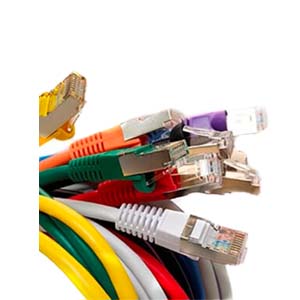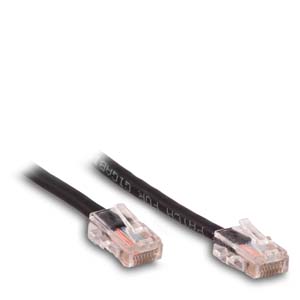Cables Blog
The Different Types of HDMI Connectors
by VIKAS DAYAL • May 14, 2020
Cables.com, Audio/Video Cables, A/V Cables, HDMI Cables

The dawn of digital video and audio has brought great advancements to video and audio equipment. Digitized signals required new kinds of cables to link a source to a receiver, and high-definition multimedia cables (HDMI) were huge improvements over previous cable types. In the past, consumers had to use up to five cables to connect a VHS or DVR player to a television or a monitor to speakers in order to produce synchronized, simultaneous video and audio signals. Today, HDMI brings all the connections into one cable.
The first HDMI cable was developed in 2002, and the technology has continued to advance ever since. HDMI cables now come in standard, high-speed, premium high-speed and ultra-high-speed versions—as well as versions capable of double-duty as both HDMI and Ethernet cables. As HDMI cables evolved and improved, so did their connectors. Initially, all HDMI cables had standard “Type A” connectors that worked with almost all components that required multimedia hookups. Now, there are several versions of ports and plugs for HDMI cables. Knowing the different types of HDMI connectors will help you understand how to connect multimedia devices for the optimal audio-visual experience.
Five Cables in One
Before HDMI cables came along, video and audio signals transferred to receivers or output devices on individual cables. Video signals transferred on DVI (digital video interface) cables. These were useful to connect monitors to computers; however, to transfer sound that might accompany a digital video signal traveling over a DVI cable, users had to employ separate audio cables. Moreover, audio signals often traveled over as many as four separate cables to transfer between devices. For example, a VCR machine that could both play and record video required a right/left audio output and a right/left audio input cable.
Some devices used S-video cables to provide a higher-quality video signal by separating the analog color from the analog brightness signals. S-video cable connectors are round, with a single-pronged male or female plug and socket type connector. S-video cable inputs now exist only on older devices because S cables can neither carry digitized signals nor match modern HDMI cables for video quality.
Display port (DP) cables are capable of transmitting both video and audio signals, but they’re typically used for multiple-monitor setups or game consoles because they can link several monitors from one source in a daisy-chain setup. HDMI cables, on the other hand, are the cables of choice for consumer electronics such as HDTVs because of their versatility, capacity, speed, and ability to carry high-definition audio and video signals simultaneously.
HDMI Connector Types
HDMI cable connections look a little bit like USB connections, but they have significant differences. For one, the original, standard Type A HDMI connector is much bigger than a USB cable. A closer look also reveals more pins in a two-tiered arrangement, with the top row shorter than the bottom row. This results in a connector terminal that’s trapezoidal rather than rectangular in appearance. When viewed head-on, the ports for USB and HDMI cables are clearly shaped differently. Receiver devices with HDMI connectors also typically have recessed female connectors built in. The connector is recessed to protect the connector from shorts and shocks.
The Type A HDMI was developed in 2002, and HDMI cables became widely available in 2003. Since then, the governing consortium that manages the proprietary standards and charges a royalty for HDMI use has introduced at least six newer standards for HDMI cables, defining resolution and refresh rates. The standards also specify parameters for the ability to simultaneously carry extreme high-quality video and audio. These new cables also introduced new versions of connectors. Here’s a rundown of the HDMI cable connector types:
Type A, Standard HDMI Connector
The original and still most-used version, Type A HDMI female connectors measure 14mm by 4.55mm, while the corresponding male connector is 13.9mm by 4.45mm. Its 19 pins can carry standard HD through ultra-high-definition 4K signals.
Type B Connector – Dual Link
Type B connectors, also known as dual-link or DVI-I connectors, were introduced at the same time as Type A, but they quickly became and were never used in standard consumer electronics, as HDMI single-link speeds outpaced the dual-link version.
Type C Connector – Mini-HDMI
Smaller versions of the Type A, mini-HDMI connectors are often found on portable devices such as camcorders. They come in versions with a Type A connector at one end and the mini-connector at the other. Type C connectors measure 10.42mm by 2.42mm.
Type D – Micro HDMI Connectors
Offering the same 19 pins in a slightly altered configuration to accommodate its smaller size, Type D micro-connectors provide multimedia connections for mobile phones and other smaller portable devices such as smaller digital cameras and mini-tablets. They measure only 5.83 by 2.2.0mm.
Type E – Automotive Connector
These connectors are designed to attach devices to video display entertainment systems in vehicles. These may have locking tabs to cope with the vibration of a moving vehicle.
Straight and Right Angle
Some HDMI cable connectors come in a right-angle version to accommodate the sharp turns necessary for components arranged in tight spaces, usually against a wall. The right-angle connector or adapter makes it possible to set up components without causing severe bends in the cables that could negatively affect performance.
Considerations When Buying HDMI Cables
Various multimedia-capable devices may require different kinds of HDMI cables or connectors. Before you purchase HDMI cables, make sure the connectors will be compatible with your devices. Cables with one type of connector on one end (usually Type A) and a different type of connector on the other end (often Type D) accommodate connections between different sizes and types of devices.
Other considerations include cable length—signals can deteriorate over long cables—and whether the setup may require what’s known as an “active” or “amplified” cable, which has the built-in ability to boost the signals it carries. Some of these amplified cables require an additional external power source. HDMI cables are also available in fiber-optic versions that can carry signals over long distances without degradation or the need for an additional power source to provide a boost. Standard home AV installations rarely, if ever, require these kinds of specialized HDMI cables. Cables.com can help you determine what type of HDMI connector and cable you may need to connect your multimedia devices.











